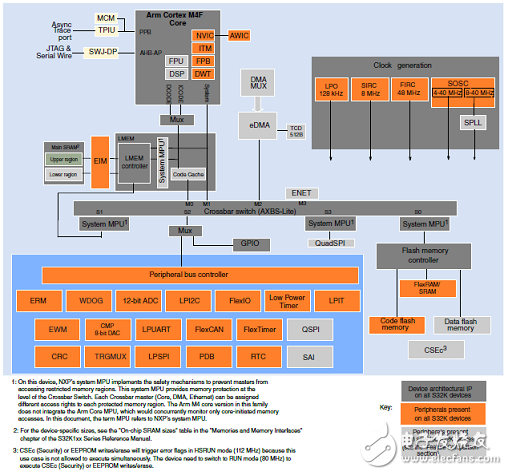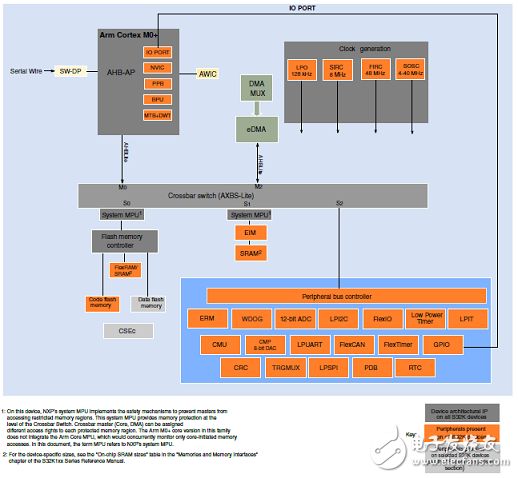
nxp公司的S32K116是满足AEC-Q100规范的基于ARM® Cortex®-M4F和ARM® Cortex®-M0+核32位MCU,集成了128KB闪存,CAN/CAN-FD控制器,遵从SHE指标的安全模块,工作电压2.7 V 到 5.5 V, RUN模式工作温度-40℃到105℃,RUN模式工作温度-40℃ 到125℃,主要用在汽车电子如车身和底盘控制,信息娱乐系统连接模块,车内空调控制(HVAC),车窗/车门/天窗,动力总成配套芯片以及PMSM/BLDC电机控制,停车辅助系统,发动机防盗锁止系统,触摸感应,安防性应用,摩托车CDI/EFI,电池管理,安全气囊,尾气后处理以及网关以及高可靠性工业应用.本文介绍了S32K116主要特性,S32K14x和S32K11x系列高级架构框图,评估板S32K116EVB主要特性和电路图.
S32K is a scalable family of AEC-Q100 qualified 32-bit Arm® Cortex®-M4F and Cortex-M0+ based MCUs targeted for general purpose automoTIve and high-reliability industrial applicaTIons.
The S32K1xx product series further extends the highly scalable portfolio of Arm®Cortex®-M0+/M4F MCUs in the automoTIve industry. It builds on the legacy of the KEA series, while introducing higher memory opTIons alongside a richer peripheral set extending capability into a variety of automotive applications. With a 2.70–5.5 V supply and focus on automotive environment robustness, the S32K product series devices are well suited to a wide range of applications in electrically harsh environments, and are optimized for cost-sensitive applications offering low pin-count options.
The S32K product series offers a broad range of memory, peripherals, and package options. It sharescommon peripherals and pin counts, allowing developers to migrate easily within anMCU family or among the MCU families to take advantage of more memory or feature integration. This scalability allows developers to use the S32K product series as the standard for their end product platforms, maximizing hardware and software reuse and reducing time to market.
S32K116主要特性:
• Operating characteristics
– Voltage range: 2.7 V to 5.5 V
– Ambient temperature range: -40℃ to 105℃ forHSRUN mode, -40℃ to 125℃ for RUN mode
• Arm™ Cortex-M4F/M0+ core, 32-bit CPU
– Supports up to 112 MHz frequency (HSRUN mode)with 1.25 Dhrystone MIPS per MHz
– Arm Core based on the Armv7 Architecture andThumb?-2 ISA
– Integrated Digital Signal Processor (DSP)
– Configurable Nested Vectored Interrupt Controller(NVIC)
– Single Precision Floating Point Unit (FPU)
• Clock interfaces
– 4 - 40 MHz fast external oscillator (SOSC) with upto 50 MHz DC external square input clock inexternal clock mode
– 48 MHz Fast Internal RC oscillator (FIRC)
– 8 MHz Slow Internal RC oscillator (SIRC)
– 128 kHz Low Power Oscillator (LPO)
– Up to 112 MHz (HSRUN) System Phased LockLoop (SPLL)
– Up to 20 MHz TCLK and 25 MHz SWD_CLK
– 32 kHz Real Time Counter external clock(RTC_CLKIN)
• Power management
– Low-power Arm Cortex-M4F/M0+ core withexcellent energy efficiency
– Power Management Controller (PMC) with multiplepower modes: HSRUN, RUN, STOP, VLPR, andVLPS. Note: CSEc (Security) or EEPROM writes/erase will trigger error flags in HSRUN mode (112MHz) because this use case is not allowed toexecute simultaneously. The device will need toswitch to RUN mode (80 Mhz) to execute CSEc (Security) or EEPROM writes/erase.
– Clock gating and low power operation supported onspecific peripherals.
• Memory and memory interfaces
– Up to 2 MB program flash memory with ECC
– 64 KB FlexNVM for data flash memory with ECCand EEPROM emulation.
Note: CSEc (Security) orEEPROM writes/erase will trigger error flags inHSRUN mode (112 MHz) because this use case isnot allowed to execute simultaneously. The devicewill need to switch to RUN mode (80 MHz) toexecute CSEc (Security) or EEPROM writes/erase.
– Up to 256 KB SRAM with ECC
– Up to 4 KB of FlexRAM for use as SRAM orEEPROM emulation
– Up to 4 KB Code cache to minimize performanceimpact of memory access latencies
– QuadSPI with HyperBus™ support
• Mixed-signal analog
– Up to two 12-bit Analog-to-Digital Converter(ADC) with up to 32 channel analog inputs permodule
– One Analog Comparator (CMP) with internal 8-bitDigital to Analog Converter (DAC)
• Debug functionality
– Serial Wire JTAG Debug Port (SWJ-DP) combines
– Debug Watchpoint and Trace (DWT)
– Instrumentation Trace Macrocell (ITM)
– Test Port Interface Unit (TPIU)
– Flash Patch and Breakpoint (FPB) Unit
• Human-machine interface (HMI)
– Up to 156 GPIO pins with interrupt functionality
– Non-Maskable Interrupt (NMI)
• Communications interfaces
– Up to three Low Power Universal Asynchronous Receiver/Transmitter (LPUART/LIN) modules with DMA supportand low power availability
– Up to three Low Power Serial Peripheral Interface (LPSPI) modules with DMA support and low power availability
– Up to two Low Power Inter-Integrated Circuit (LPI2C) modules with DMA support and low power availability
– Up to three FlexCAN modules (with optional CAN-FD support)
– FlexIO module for emulation of communication protocols and peripherals (UART, I2C, SPI, I2S, LIN, PWM, etc).
– Up to one 10/100Mbps Ethernet with IEEE1588 support and two Synchronous Audio Interface (SAI) modules.
• Safety and Security
– Cryptographic Services Engine (CSEc) implements a comprehensive set of cryptographic functions as described in theSHE (Secure Hardware Extension) Functional Specification. Note: CSEc (Security) or EEPROM writes/erase willtrigger error flags in HSRUN mode (112 MHz) because this use case is not allowed to execute simultaneously. Thedevice will need to switch to RUN mode (80 MHz) to execute CSEc (Security) or EEPROM writes/erase.
– 128-bit Unique Identification (ID) number
– Error-Correcting Code (ECC) on flash and SRAM memories
– System Memory Protection Unit (System MPU)
– Cyclic Redundancy Check (CRC) module
– Internal watchdog (WDOG)
– External Watchdog monitor (EWM) module
• Timing and control
– Up to eight independent 16-bit FlexTimers (FTM) modules, offering up to 64 standard channels (IC/OC/PWM)
– One 16-bit Low Power Timer (LPTMR) with flexible wake up control
– Two Programmable Delay Blocks (PDB) with flexible trigger system
– One 32-bit Low Power Interrupt Timer (LPIT) with 4 channels
– 32-bit Real Time Counter (RTC)
• Package
– 32-pin QFN, 48-pin LQFP, 64-pin LQFP, 100-pin LQFP, 100-pin MAPBGA, 144-pin LQFP, 176-pin LQFP packageoptions
• 16 channel DMA with up to 63 request sources using DMAMUXapplications, which include but not limited to:
• Exterior and interior lighting
• HVAC
• Door/Window/Wiper/Seat controller
• BLDC/PMSM motor control
• Park assistant
• E-shifter
• TPMS
• Real time control in infotainment system
• Battery management system
• Human machine interface such as touch sense control
• Secured vehicle data transfer
• Safety controller
• Over the air update

图1.S32K14x系列高级架构框图

图2.S32K11x系列高级架构框图
S32K116评估板S32K116EVB
The S32K116EVB is a low-cost evaluation platform and development system for quick application prototyping and demonstration. It features the S32K116 microcontroller for general purpose automotive applications. The S32K116 features an ARM Cortex-M0+ core, 128 KB of Flash, a CAN/CAN-FD controller, security module complying with SHE specification and offered in 32QFN and 48LQFP packages supporting an ambient temperature range from -40℃ up to 125℃.
评估板S32K116EVB主要特性:
Supports48LQFP and 32QFN packages
Small form factor size 4.5” x 2.3”
Arduino™ UNO footprint-compatible with expansion “shield” support
Integrated open-standard serial and debug adapter (OpenSDA) with support for several industry-standard debug interfaces
On-chip connectivity for CAN, LIN, UART/SCI.
SBC UJA1169 and LIN phyTJA1027
Potentiometer for precise voltage and analog measurement
RGB LED
Two push-button switches (SW2 and SW3) and two touch electrodes
Flexible power supply optionsmicroUSB
external 12V power supply
欢迎分享,转载请注明来源:内存溢出

 微信扫一扫
微信扫一扫
 支付宝扫一扫
支付宝扫一扫
评论列表(0条)